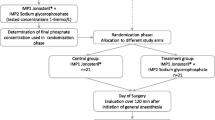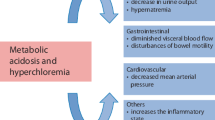Abstract
Purpose
Large infusion of crystalloids may induce acid-base alterations according to their strong ion difference ([SID]). We wanted to prove in vivo, at constant PCO2, that if the [SID] of the infused crystalloid is equal to baseline plasma bicarbonate, the arterial pH remains unchanged, if lower it decreases, and if higher it increases.
Methods
In 12 pigs, anesthetized and mechanically ventilated at PCO2 ≈40 mmHg, 2.2 l of crystalloids with a [SID] similar to (lactated Ringer’s 28.3 mEq/l), lower than (normal saline 0 mEq/l), and greater than (rehydrating III 55 mEq/l) baseline bicarbonate (29.22 ± 2.72 mEq/l) were infused for 120 min in randomized sequence. Four hours of wash-out were allowed between the infusions. Every 30 min up to minute 120 we measured blood gases, plasma electrolytes, urinary volume, pH, and electrolytes. Albumin, hemoglobin, and phosphates were measured at time 0 and 120 min.
Results
Lactated Ringer’s maintained arterial pH unchanged (from 7.47 ± 0.06 to 7.47 ± 0.03) despite a plasma dilution around 12%. Normal saline caused a reduction in pH (from 7.49 ± 0.03 to 7.42 ± 0.04) and rehydrating III induced an increase in pH (from 7.46 ± 0.05 to 7.49 ± 0.04). The kidney reacted to the infusion, minimizing the acid-base alterations, by increasing/decreasing the urinary anion gap, primarily by changing sodium and chloride concentrations. Lower urine volume after normal saline infusion was possibly due to its greater osmolarity and chloride concentration as compared to the other solutions.
Conclusions
Results support the hypothesis that at constant PCO2, pH changes are predictable from the difference between the [SID] of the infused solution and baseline plasma bicarbonate concentration.


Similar content being viewed by others
References
Williams EL, Hildebrand KL, McCormick SA, Bedel MJ (1999) The effect of intravenous lactated Ringer’s solution versus 0.9% sodium chloride solution on serum osmolality in human volunteers. Anesth Analg 88:999–1003
Scheingraber S, Rehm M, Sehmisch C, Finsterer U (1999) Rapid saline infusion produces hyperchloremic acidosis in patients undergoing gynecologic surgery. Anesthesiology 90:1265–1270
O’Malley CM, Frumento RJ, Hardy MA, Benvenisty AI, Brentjens TE, Mercer JS, Nett-Guerrero E (2005) A randomized, double-blind comparison of lactated Ringer’s solution and 0.9% NaCl during renal transplantation. Anesth Analg 100:1518–1524, table
Fencl V, Leith DE (1993) Stewart’s quantitative acid-base chemistry: applications in biology and medicine. Respir Physiol 91:1–16
Stewart PA (1983) Modern quantitative acid-base chemistry. Can J Physiol Pharmacol 61:1444–1461
Doberer D, Funk GC, Kirchner K, Schneeweiss B (2009) A critique of Stewart’s approach: the chemical mechanism of dilutional acidosis. Intensive Care Med 35:2173–2180
Carlesso E, Maiocchi G, Tallarini F, Polli F, Valenza F, Cadringher P, Gattinoni L (2010) The rule regulating pH changes during crystalloid infusion. Intensive Care Med 37:461–468
Gattinoni L, Carlesso E, Maiocchi G, Polli F, Cadringher P (2009) Dilutional acidosis: where do the protons come from? Intensive Care Med 35:2033–2043
Morgan TJ, Venkatesh B, Hall J (2004) Crystalloid strong ion difference determines metabolic acid-base change during acute normovolaemic haemodilution. Intensive Care Med 30:1432–1437
Institute of Laboratory Animal Resources ColSNRC (1996) Guide for the care and use of laboratory animals. National Academy Press, Washington
Protti A, Cressoni M, Santini A, Langer T, Mietto C, Febres D, Chierichetti M, Coppola S, Conte G, Gatti S, Leopardi O, Masson S, Lombardi L, Lazzerini M, Rampoldi E, Cadringher P, Gattinoni L (2011) Lung stress and strain during mechanical ventilation: any safe threshold? Am J Respir Crit Care Med 183:1354–1362
Caironi P, Langer T, Taccone P, Bruzzone P, De CS, Vagginelli F, Caspani L, Marenghi C, Gattinoni L (2010) Kidney instant monitoring (K.IN.G): a new analyzer to monitor kidney function. Minerva Anestesiol 76:316–324
Ewaldsson CA, Hahn RG (2005) Kinetics and extravascular retention of acetated ringer’s solution during isoflurane or propofol anesthesia for thyroid surgery. Anesthesiology 103:460–469
Fencl V, Jabor A, Kazda A, Figge J (2000) Diagnosis of metabolic acid-base disturbances in critically ill patients. Am J Respir Crit Care Med 162:2246–2251
Hannon JP, Bossone CA, Wade CE (1990) Normal physiological values for conscious pigs used in biomedical research. Lab Anim Sci 40:293–298
Gennari FJ, Goldstein MB, Schwartz WB (1972) The nature of the renal adaptation to chronic hypocapnia. J Clin Invest 51:1722–1730
Polak A, Haynie GD, Hays RM, Schwartz WB (1961) Effects of chronic hypercapnia on electrolyte and acid-base equilibrium. I. Adaptation. J Clin Invest 40:1223–1237
Hansen PB, Jensen BL, Skott O (1998) Chloride regulates afferent arteriolar contraction in response to depolarization. Hypertension 32:1066–1070
Wilcox CS (1983) Regulation of renal blood flow by plasma chloride. J Clin Invest 71:726–735
Bagshaw SM, George C, Dinu I, Bellomo R (2008) A multi-centre evaluation of the RIFLE criteria for early acute kidney injury in critically ill patients. Nephrol Dial Transplant 23:1203–1210
Bagshaw SM, Lapinsky S, Dial S, Arabi Y, Dodek P, Wood G, Ellis P, Guzman J, Marshall J, Parrillo JE, Skrobik Y, Kumar A (2009) Acute kidney injury in septic shock: clinical outcomes and impact of duration of hypotension prior to initiation of antimicrobial therapy. Intensive Care Med 35:871–881
Joannidis M, Metnitz B, Bauer P, Schusterschitz N, Moreno R, Druml W, Metnitz PG (2009) Acute kidney injury in critically ill patients classified by AKIN versus RIFLE using the SAPS 3 database. Intensive Care Med 35:1692–1702
Acknowledgments
We are grateful to Fabio Ambrosetti for his technical support, to GE Healthcare for providing mechanical ventilators, to A. De Mori S.p.A., Italy, who kindly provided the blood gas analyzer, and to Roberto Castenetto for technical support with the KING analyzer. This study was supported in part by an Italian grant provided by Fondazione Fiera di Milano for Translational and Competitive Research (2007, Luciano Gattinoni).
Author information
Authors and Affiliations
Corresponding author
Electronic supplementary material
Below is the link to the electronic supplementary material.
Rights and permissions
About this article
Cite this article
Langer, T., Carlesso, E., Protti, A. et al. In vivo conditioning of acid–base equilibrium by crystalloid solutions: an experimental study on pigs. Intensive Care Med 38, 686–693 (2012). https://doi.org/10.1007/s00134-011-2455-2
Received:
Accepted:
Published:
Issue Date:
DOI: https://doi.org/10.1007/s00134-011-2455-2




